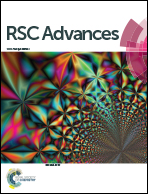Inorganic composite adsorbent CaCl2/MWNT for water vapor adsorption†
Abstract
CaCl2 has been proposed as an advanced chemical adsorbent for cheap, non-toxic and powerful in water vapour adsorption. One of the key barriers for practical application is poor in mass and heat transfer due to large volume expansion, serious agglomeration and low thermal conductivity. A novel CaCl2/MWNT adsorbent is prepared with carbon nanotube as matrix. In the composite, a part of CaCl2 nanoparticles are adsorbed on the matrix surface, and the else hygroscopic salts are filled in the space of matrices. The nanoparticles with big specific surface areas can be fully contacted with water vapour, enhancing water uptake and adsorption rate. Furthermore, the paper has reported that hydrophilic/hydrophobic property of the MWNT is relation with the adsorption performances of the CaCl2/MWNT composite. It is found that hydrophilic matrix can enhance water-retaining property, and keep a stable porous structure of the material. Finally, a simple modified method adding PVP as a water-based adhesive into the CaCl2/MWNT composite adsorbent is also reported for the first time. The PVP powder improves water-retaining property of the CaCl2/MWNT adsorbent during adsorption process. For regeneration process, the PVP water-based adhesive makes adsorbent particles agglomerate macroscopically under unchanged their microcosmic structure. At low humidity condition, adsorption rate of CaCl2/MWNT composite is obviously enhanced by the PVP powder. Consequently, the modified CaCl2/MWNT composite with the hydrophilic matrix will promise for commercial application in water vapour extraction, thermal storage energy and other applications.


 Please wait while we load your content...
Please wait while we load your content...